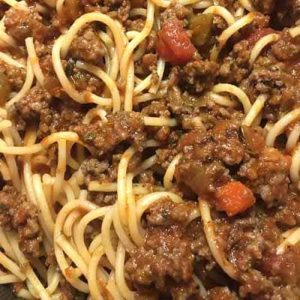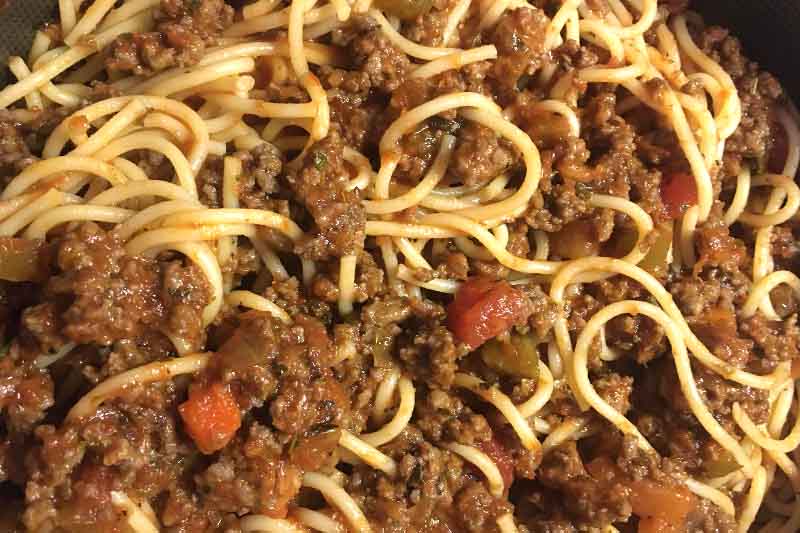Old Fashioned Spaghetti: A Timeless Classic
History and Origin of Old Fashioned Spaghetti
Old Fashioned Spaghetti, a staple of Italian cuisine, has a storied past that intertwines with the history of Italy and the broader Mediterranean region. The origins of spaghetti date back to ancient times, with references to pasta-like dishes in Roman and Greek texts. However, the spaghetti we know today, long, thin, and made from durum wheat, began to take shape in the Middle Ages in Italy.
The term old fashioned spaghetti typically refers to a style of preparation that harkens back to these earlier times. It’s characterized by simplicity and the use of fresh, high-quality ingredients. The evolution of spaghetti into this style is a testament to the dish’s versatility and enduring appeal. In its most traditional form, old fashioned spaghetti is often served with a simple tomato sauce, enhanced with herbs like basil and garlic, and sometimes with the addition of meats or vegetables.
This evolution was not just confined to Italy. As Italians emigrated to other parts of the world, they brought their culinary traditions with them, leading to the global popularity of spaghetti. Each region adapted the dish to local tastes and available ingredients, creating a rich tapestry of variations on the classic spaghetti. Learn more about the rich history of pasta and its journey across cultures.
Cultural Significance
In Italian cuisine, spaghetti is more than just a food item; it’s a cultural icon. It represents the heart of Italian cooking philosophy: high-quality ingredients, regional flavors, and a balance between simplicity and elegance. In Italy, the preparation of spaghetti is often considered an art form, with each region boasting its own signature spaghetti dish, from the seafood-laden spaghetti alle vongole of Naples to the rich, meaty ragù typical of Bologna’s spaghetti Bolognese.
As spaghetti traveled the world, it took on new forms and meanings. In the United States, for example, spaghetti became a symbol of Italian-American identity, often served in heaping portions with meatballs and a rich tomato sauce. In other cultures, spaghetti has been adapted to local cuisines, incorporating unique ingredients and cooking methods.
This adaptability of spaghetti not only shows its universal appeal but also highlights how food can be a bridge between cultures, evolving and adapting while still retaining its core identity. The story of spaghetti is thus not just a culinary tale but also a narrative of migration, adaptation, and cultural exchange.
Ingredients and Preparation
Key Ingredients
The essence of old fashioned spaghetti lies in its simplicity and the use of traditional ingredients. At its core, this dish is a celebration of minimalism, where each component is chosen for its quality and ability to harmonize with the overall flavor.
- Pasta: The star of the dish is, of course, the spaghetti itself. Traditionally made from durum wheat semolina, it offers a firm texture and a perfect surface for sauces to cling to.
- Tomatoes: Fresh, ripe tomatoes form the basis of the classic sauce. They provide a balance of sweetness and acidity, crucial for the sauce’s flavor profile.
- Garlic and Onions: These aromatics are foundational in creating a depth of flavor. Garlic, in particular, is used judiciously to infuse the sauce without overpowering it.
- Olive Oil: A good quality extra-virgin olive oil adds richness and a distinct Mediterranean character to the dish.
- Herbs: Basil and oregano are the herbs most commonly used. Fresh basil adds a sweet, peppery flavor, while oregano contributes its earthy, slightly bitter taste.
- Cheese: Parmesan or Pecorino Romano cheese, finely grated, is often used as a garnish, adding a salty, umami depth.
Modern variations and substitutes cater to diverse dietary needs and preferences:
- Gluten-Free Pasta: Made from corn, rice, or quinoa flour, it’s a great alternative for those avoiding gluten.
- Vegan Options: Plant-based cheese substitutes and meatless sauces can be used to make the dish vegan.
- Meat Additions: Ground beef, meatballs, or pancetta can be added for a heartier meal.
Step-by-Step Cooking Guide
Creating the perfect old fashioned spaghetti requires attention to detail and a respect for the ingredients. Here’s a step-by-step guide:
- Cook the Spaghetti: Bring a large pot of salted water to a boil. Add the spaghetti and cook until al dente, usually about 8-10 minutes. Drain, reserving a cup of pasta water.
- Prepare the Sauce: While the pasta cooks, heat olive oil in a pan over medium heat. Add finely chopped onions and minced garlic, sautéing until translucent. Add crushed tomatoes, salt, pepper, and a pinch of sugar to balance the acidity. Simmer on low heat for about 15-20 minutes, allowing the flavors to meld.
- Herb Infusion: Add chopped fresh basil and oregano in the last few minutes of cooking the sauce. This preserves their aroma and flavor.
- Combine: Toss the cooked spaghetti into the sauce, adding a bit of the reserved pasta water to help the sauce cling to the pasta.
- Serve: Plate the spaghetti, and finish with a drizzle of olive oil, a sprinkle of grated cheese, and a few basil leaves for garnish.
Tips for Perfect Texture and Flavor:
- Pasta Water: The starchy pasta water is key to creating a silky, well-emulsified sauce that adheres to the spaghetti.
- Sauce Consistency: The sauce should be neither too thick nor too thin. It needs to coat the pasta without weighing it down.
- Seasoning: Balance the flavors with proper seasoning. Salt is crucial, and a hint of pepper can add a subtle warmth.
- Fresh Ingredients: Use the freshest ingredients for the best flavor, especially when it comes to herbs and tomatoes.
Following these steps and tips will help you create a classic old fashioned spaghetti that’s both comforting and delicious, embodying the essence of traditional Italian cooking.
Nutritional Value and Dietary Considerations
Health Benefits
Old fashioned spaghetti, particularly when made with whole grain pasta, offers a range of nutritional benefits. Whole grain pasta, a healthier alternative to its refined counterpart, retains the bran and germ of the wheat, providing a richer source of nutrients.
- Fiber: Whole grain pasta is high in dietary fiber, which is beneficial for digestive health and helps in maintaining a feeling of fullness, aiding in weight management.
- Vitamins and Minerals: It is a good source of several essential nutrients, including B vitamins, iron, magnesium, and selenium.
- Low Glycemic Index: Whole grain pasta has a lower glycemic index compared to refined pasta, meaning it causes a slower rise in blood sugar levels, making it a better option for blood sugar control.
- Heart Health: Regular consumption of whole grains is linked to a reduced risk of heart disease, partly due to the fiber and beneficial compounds found in whole grains.
Discover the nutritional benefits of whole grain pasta and how it contributes to a balanced diet.
Dietary Adaptations
Old fashioned spaghetti can be adapted to suit various dietary needs without compromising on taste or texture.
- Gluten-Free Variations: For those with celiac disease or gluten sensitivity, gluten-free pasta made from rice, corn, or quinoa flour is an excellent substitute. These alternatives mimic the texture of traditional pasta and are widely available.
- Vegan Variations: To make a vegan version, use plant-based cheese and a meat-free sauce. Ingredients like nutritional yeast can add a cheesy flavor without dairy.
- Low-Carb Alternatives: For a low-carb option, spaghetti squash or spiralized vegetables like zucchini can replace traditional pasta. These alternatives offer a similar experience with a fraction of the carbohydrates.
These adaptations ensure that old fashioned spaghetti remains accessible and enjoyable for everyone, regardless of dietary restrictions or health goals. By choosing the right ingredients, it’s possible to create a dish that is not only delicious but also aligns with various nutritional needs.
Serving and Pairing
Serving Suggestions
Old fashioned spaghetti is a versatile dish that can be served in various traditional and creative ways. The key to a memorable serving lies in both the presentation and the accompaniments.
- Plating: Serve the spaghetti twirled neatly on the plate, topped with a generous spoonful of sauce. Garnish with a sprinkle of grated Parmesan cheese and a few fresh basil leaves for a pop of color.
- Portion Size: A standard serving size is about one cup of cooked pasta, but this can be adjusted based on appetite and occasion.
- Accompaniments: A simple side salad, such as a classic Caesar or a light arugula salad, complements the richness of the spaghetti. Freshly baked garlic bread is another popular accompaniment, perfect for soaking up any leftover sauce.
Presentation tips to enhance the dining experience:
- Color Contrast: Use white or lightly colored plates to make the vibrant red of the tomato sauce stand out.
- Garnishing: A final drizzle of high-quality olive oil just before serving can add a glossy finish and an extra layer of flavor.
Pairing with Other Dishes
The right pairings can elevate old fashioned spaghetti into a complete and balanced meal.
- Side Dishes: Consider light vegetable sides like steamed broccoli, sautéed spinach, or a mixed vegetable medley. These sides add nutritional value and a contrasting texture to the meal.
- Wine Pairings: A medium-bodied red wine like Chianti or Merlot pairs well with the tomato-based sauce, complementing its acidity and richness. For a lighter sauce or a summer meal, a crisp white wine like Pinot Grigio can be a refreshing choice.
- Balancing Flavors: The key is to balance the hearty, savory flavor of the spaghetti with sides and wines that either complement or provide a refreshing contrast. Avoid overly heavy or rich additions that might overpower the main dish.
By thoughtfully combining old fashioned spaghetti with suitable sides and wines, you can create a harmonious and satisfying dining experience that celebrates the flavors and traditions of Italian cuisine. Explore wine pairings for Italian meals to complete your dining experience.

Old Fashioned Spaghetti Recipe
Equipment
- Large pot for boiling pasta
- Skillet or saucepan for the sauce
- Colander for draining pasta
- Wooden spoon or spatula for stirring
- Cheese grater for Parmesan cheese
Ingredients
- 1 pound spaghetti
- 2 tablespoons extra-virgin olive oil
- 1 medium onion finely chopped
- 3 cloves garlic minced
- 1 can 28 ounces crushed tomatoes
- 1 teaspoon sugar optional
- Salt and freshly ground black pepper to taste
- 1/2 teaspoon dried oregano
- A handful of fresh basil leaves chopped
- Grated Parmesan cheese for serving
Instructions
Cook the Spaghetti:
- Bring a large pot of salted water to a boil. Add the spaghetti and cook according to the package instructions until al dente. Drain and set aside, reserving a cup of the pasta water.
Prepare the Sauce:
- While the pasta is cooking, heat the olive oil in a large skillet over medium heat. Add the chopped onion and sauté until translucent, about 5 minutes.
- Add the minced garlic and cook for another minute until fragrant.
- Stir in the crushed tomatoes. Add sugar if using, to balance the acidity of the tomatoes.
- Season with salt, pepper, and dried oregano. Let the sauce simmer for about 15-20 minutes, allowing the flavors to meld together.
Combine Pasta and Sauce:
- Add the cooked spaghetti to the sauce, tossing well to coat. If the sauce is too thick, add a little of the reserved pasta water to reach your desired consistency.
Final Touches:
- Stir in the fresh basil just before serving.
- Serve the spaghetti hot, topped with a generous sprinkle of grated Parmesan cheese.
Serve:
- Plate the spaghetti with a garnish of more fresh basil, if desired. Offer additional Parmesan cheese at the table for guests to add to their liking.
Notes
- For a richer flavor, consider adding a splash of red wine to the sauce while it simmers.
- If you prefer a bit of heat, a pinch of red pepper flakes can be added.
- Fresh herbs are preferable for the best flavor, but dried herbs can be used in a pinch.
- The sauce can be made ahead and stored in the refrigerator for up to 3 days or frozen for longer storage.








Leave a Comment